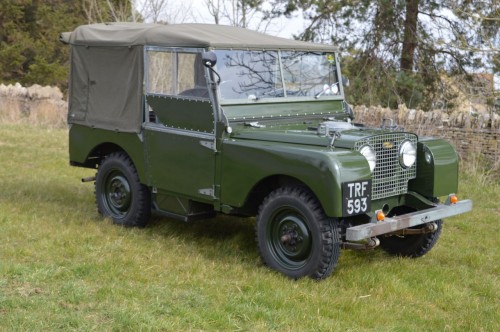
Click Here for Full Screen Image - Click Here to Download Image
 |  |  |  |  | |||||
 |  |  |  |  | |||||
 |  |  |  |  | |||||
 |  |
| Lot number | 82 |
|---|---|
| Hammer value | £28,500 |
| Description | Land Rover Series 1 80-inch |
| Registration | TRF 593 |
| Year | 1950 |
| Colour | Green |
| Engine size | 1,595 cc |
| Chassis No. | 06111767 |
| Documents | V5C; 11 old MOTs; huge file of invoices; comprehensive usage log |
Land Rovers have now become such a common sight on Britain's roads that it is hard to imagine life without them.
However, the world had somehow struggled along without these go-anywhere marvels until Maurice Wilks had a bright idea in 1947. Taking a war surplus American Jeep as his inspiration, the Rover chief designer messed around with prototypes on his farm in Anglesey until he perfected the vehicle that was launched at the Amsterdam Motor Show in 1948.
One of the many distinctive features of the Land Rover was the bodywork, constructed of a lightweight alloy of aluminium and magnesium called Birmabright. Used solely due to post-war steel shortages and a plentiful supply of aircraft aluminium, it's resistance to corrosion was one of the key factors that earned the vehicle a legendary reputation for longevity in the toughest conditions. The early choice of colour was also dictated by circumstance – military surplus paint was the cheapest available, so it was a case of any colour you want, so long as it's green.
From 1948 until 1951 the Land Rover was only offered with an 80-inch wheelbase and a 1.6-litre petrol engine. So basic was it that tops for the doors and a roof (canvas or metal) were optional extras. In 1950, the headlights moved from a position behind the grille to protruding through it. From 1952 the engine gained an extra 2bhp, however was a lot more torquey thanks to an increase to 1997cc. The 80-inch carried on until 1954 when the longer wheelbase 86-inch came along with its extra carrying capacity.
This highly original 1950 80-inch was despatched on 4th May 1950 to Attwoods Garage in Stafford. It was registered the following day and delivered to Mr Alfred Johnson of nearby Chartley Hall to work on his Staffordshire estate. According to the buff logbook, it then migrated to Wellman Smith Owen Ltd, steelworks engineers, furnace and crane builders, a company with connections to Mr Johnson, where it worked in the confines of the factory.
It is for this reason that the owner believes the mileage, which showed just 24,500 miles on the odometer when the vehicle was acquired by his late brother in 1988, is correct, the general condition of the vehicle substantiating its use indoors as a ‘shunter’ within the works – the car even retaining two of its original tyres at that time.
Recommissioned for the road, it enjoyed a brief period from 1989 - 1990 driving under its own power, before the inevitable comprehensive restoration commenced. When stripped to its constituent parts, it was discovered that the main components were still in remarkable condition, in particular the usually rust-prone chassis and bulkhead. The rebuild progressed to the rolling-chassis stage when sadly the vendor’s brother passed away in 2001. Taking over the project, the vendor completed the restoration to the high standard we see here in around 2003.
A stickler for originality, every effort was made to keep things as they should be, modern direction indicators being mounted in such a way that no holes needed to be drilled. The steering wheel was professionally refurbished along with a new tilt and seat bases from Exmoor Trim. Every item was carefully detailed and attended to.
Dunsfold Land Rover had a hand in much of the work too, including rebuilding the original gearbox which had suffered from its life in the factory and the body paintwork was taken care of by GM of Chiddingfold.
After a period of active use, including attending no fewer than eight Series 1 Talyllyn Rallies, the vendor decided that an annoying water-leak from some ancient frost damage to the block really needed sorting. He enlisted renowned engine builders Cox & Turner to completely rebuild a replacement 1,600cc engine, although the original unit which remains eminently repairable is included in the sale should its new owner wish to return the car to fully matching numbers status in the future. This work was completed in 2014, the car having covered just 750 miles since then.
The document file includes detailed notes on everything spent on it and every journey it has undertaken since 2003 showing how the mileage has increased to just 34,000 miles, along with masses of bills and invoices and an article from issue 117 of the Series One Club magazine 'Legend’ detailing the car’s history.
It is being sold with its original and rare tow-hitch as well as numerous boxes of useful parts which include a new exhaust, electrical components including an original voltage regulator, tools, a water pump, hoses and many fixtures and fittings including the original rear D-lamp casings, replacements having been fitted during the car’s rebuild. Larger items include two spare wheels and two door tops.
Many renovated Series Ones seem to have lost their soul through over-restoration or the fitment of non-original parts. This prime example retains all of its major components (with the exception of the engine of course although this remains with the vehicle), which have survived in remarkable condition thanks to its early history. Sympathetically restored to a very high standard, the writer can confirm that it felt extremely taut and rattle-free on the extended test drive to take the photographs, its fresh engine pulling well despite still requiring final running-in.
One for the serious Series Land Rover collector, this example needs nothing more than a new owner to take over the reins.